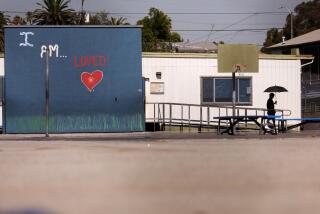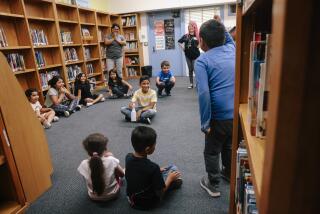Short summer for some Chino students
School’s out for summer -- except for hundreds of children in western San Bernardino County who, because of an administrative snafu, must make up 34 days of school this summer.
The fourth-, fifth- and sixth-graders at Rolling Ridge Elementary in Chino Hills and Dickson Elementary in Chino exceeded the state’s requirement of minutes spent in the classroom, and the last day of school was supposed to be Thursday. But because of the complexities of state law and a clerical error on a spreadsheet, the Chino Unified School District will lose more than $7 million in state funds if classes end at the schools before July 31.
“I’m appalled. I’m just really kind of amazed the state would . . . take it out on the kids,” said Michelle Knight, whose son, Tristan, is a Dickson fifth-grader.
Knight said the family’s summer schedule is already packed: Mother and son are taking a road trip to Washington to visit family this month, and Tristan is going camping in July with his father, who lives in Colorado. The 11-year-old also has swim meets with the Chino Valley Dolphins team, community theater rehearsals and Boy Scout camp-outs.
“He needs a break. He’s a kid,” said Knight, a teacher.
Rolling Ridge fourth-grader Sean Cornish said the extended school year would interfere with his plans to spend time with family and swim in his family’s backyard pool.
“Oh, mannnnn,” said the 10-year-old, adding that the subject has been a frequent topic of conversation among his classmates. “They think it’s dumb, that they have to go to school for these extra days because some lady messed up.”
School officials are sympathetic.
“We made an error on the minimum days of about five minutes,” said Dickson Principal Sue Pederson. “Realistically, that’s our accounting mistake as adults. We’re unfortunately making the children pay for it by making them give up their summer.”
Students at each school exceeded the state’s requirement of at least 54,000 minutes of annual classroom time, but the problem arose in the district’s minimum days. Schools typically have one shortened day per week, allowing teachers to use the remaining time for planning and parent conferences. Under state law, these days must be at least 180 minutes, and the daily average classroom time over 10 consecutive days must be 240 minutes.
An internal audit in early May discovered that 34 minimum days had been 175 minutes at Dickson and 170 at Rolling Ridge, said district spokeswoman Julie Gobin. That adds up to a shortage of 170 and 340 minutes, respectively, which could be made up in one or two school days. But under state law, these too-short days do not count at all, meaning that all 34 must be made up to avoid a state penalty of more than $7 million.
“The penalties for not meeting the instructional time requirements are high, much higher than just making up of the time,” said Hilary McLean, spokeswoman for the state Department of Education. “It was the intent of the Legislature to make the penalties so stiff [in order] to discourage districts from shaving off minutes here and there.”
An associate superintendent at the district, who is retiring this year, has taken responsibility for the errors.
Legislation was introduced last month to give the district some relief and is scheduled to be heard in the Assembly Education Committee on Wednesday. Then it goes to the Appropriations Committee, the Assembly floor and then the Senate.
“I wish we didn’t have to go through this process to get this fixed. The rules and regulations are so bureaucratic,” said Assemblyman Curt Hagman (R-Chino Hills), who wrote the bill. “It’s common sense.”
Because of the timing, and the uncertainty of the bill’s prospects, the district is planning 34-day extensions at Dickson and Rolling Ridge, which will cost about $200,000. The financial stakes are too high not to do so, Gobin said.
The district has recently cut $44 million from its $273-million budget, including closing three elementary schools, laying off 172 teachers and increasing class sizes in kindergarten through third grade, she said.
School leaders are trying to turn the unexpected summer session into something special for the children, including arts, music and hands-on science experiments that are increasingly rare in classrooms. The extra instruction also will allow students to get a jump on next year’s curriculum, which appealed to parents such as Nancy Smith, whose daughter Cassidy is in sixth grade.
“It will help prepare her for junior high,” Smith said.
Schools are offering independent study packets for students who can’t attend the sessions. A survey by the district indicated that roughly half of the 500 students affected will attend school and the other half will study independently.
But based on interviews with parents as they picked up their children at Dickson last week, that projection seems optimistic. Smith was one of two parents interviewed who planned to send their children to school. More than a dozen others said summer plans -- such as pre-paid sleep-away camps and family vacations -- would take precedence.
“It’s the school’s fault,” said Yadira Labrada, as she waited for her sixth-grader son. “I’m not doing it.”
--
More to Read
Sign up for Essential California
The most important California stories and recommendations in your inbox every morning.
You may occasionally receive promotional content from the Los Angeles Times.











